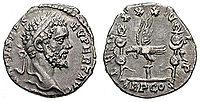
Legio XXX Ulpia Victrix ("Trajan's Victorious Thirtieth Legion") was a legion of the Imperial Roman army. Their emblems were the gods Neptune and Jupiter and the Capricorn. Ulpia is Trajan's own gens, while the cognomen "Victrix" means "victorious," and it was awarded after their valiant behaviour in the Dacian Wars. The legion was active until the disbandment of the Rhine frontier in the beginning of the 5th century.
History

It was founded in AD 100 by the emperor Trajan for service in the Dacian Wars.
The legion's first base camp was in the province of Dacia in the Danube frontier. It is likely that at least some of its legionaries took part in the Parthian campaigns of Trajan. In 122 they were moved to Colonia Ulpia Traiana (modern Xanten) in Germania Inferior, where they remained for the following centuries. Their main tasks were public construction and police affairs.
In the 2nd century and the beginning of the 3rd century, units of the XXX Ulpia Victrix were allocated in Parthia, as well as Gaul, Mauretania and other Roman provinces, due to the peaceful situation in Germania Inferior. They fought in Antoninus Pious' campaigns in Mauritania.
In the civil war of 193, XXX Ulpia Victrix supported Septimius Severus, who granted them the title of Pia Fidelis ("faithful and loyal").
The legion was used by Emperor Alexander Severus in his 235 campaign against the Sassanids. Later the legion would be involved in Alexander Severus' campaign on the Rhine Frontier. It was almost certainly involved in Gallienus's wars against the Franks in the 250s. L. Petronius Taurus Volusianus was Primus Pilus of the legion at this time. It supported the Gallic Empire of Postumus (260–274) and suffered great losses when Aurelian overthrew Tetricus I in a bloody battle at the Catalaunian Fields in 274.

With the re-organization of the Roman Army (Constantius I Chlorus), the legions guarding the border lost their importance to the comitatus, the main, cavalry-based army behind the limes. The collapse of the Rhine frontier after 408–410 marked the end of the legion's history.
Attested members
| Name | Rank | Time frame | Province | Source |
|---|---|---|---|---|
| Lucius Aemilius Carus | legatus | c. 135 | Germania Inferior | CIL VI, 1333 |
| Gnaeus Julius Verus | legatus | c. 144-c. 147 | Germania Inferior | CIL III, 2732 |
| Gaius Julius Severus | legatus | c. 147-c. 150 | Germania Inferior | CIG 4029 = ILS 8829 |
| Egr | legatus | 161/169 or 177/180 | Germania Inferior | AE 1969/70, 82 |
| Lucius Saevinius Proculus | legatus | c. 170-c. 172 | Germania Inferior | AE 1969/70, 601 |
| Quintus Marcius Gallianus | legatus | c. 220 | Germania Inferior | CIL XIII, 8810 |
| Cannutius Modestus | legatus | c. 223 | Germania Inferior | CIL XIII, 8607 |
| Quintus Petronius Melior | legatus | 3rd century | Germania Inferior | CIL XI, 3367 |
| Gaius Junius Faustinus | legatus | 3rd century | Germania Inferior | |
| Gaius Julius Septimius Castinus | Dux | 3rd century | Germania Inferior | |
| Gaius Cattanius Tertius | legionary | 3rd Century | Germania Inferior | |
| Titus Caesonnius Quinctianus | military tribune | c. 125 | Germania Inferior | CIL V, 865 |
| Petronus Fortunatus | legionary | 2nd Century | Germania Inferior | |
| Lucius Petronius Taurus Volusianus | primus pilus | c. 253 | Germania Inferior | CIL XI, 1836 |
| "Valentinus" | unknown | c. 175 | Germania Inferior/Britannia | Colchester Vase |
See also
References
- Hebblewhite, Mark (2016-12-19). The Emperor and the Army in the Later Roman Empire, AD 235-395. Taylor & Francis. ISBN 978-1-317-03430-8.
- Wheeler, Everett L. Rome's Dacian Wars: Domitian, Trajan, and Strategy on the Danube, Part II.
- Bishop, M. C. (2013-01-08). Handbook to Roman Legionary Fortresses. Pen and Sword. ISBN 978-1-4738-1774-6.
- ^ Benett, Julian (2008). The Legio XXX Ulpia Victrix Pia Fidelis And Severus' Expeditions Asiana and Mesopotamia. Romish-Germanisches Zentralmuseum.
- ^ Ezov, Amiram (2007). "The Centurions in the Rhine Legions in the Second and Early Third Century". Historia: Zeitschrift für Alte Geschichte. 56 (1): 46–81. doi:10.25162/historia-2007-0005. ISSN 0018-2311. JSTOR 25598375. S2CID 160746901.
- McHugh, John S. (2017-06-30). Emperor Alexander Severus: Rome's Age of Insurrection, AD 222–235. Pen and Sword. ISBN 978-1-4738-4582-4.
- ^ Géza Alföldy, Konsulat und Senatorenstand unter der Antoninen (Bonn: Rudolf Habelt Verlag, 1977), p. 302
- ^ Paul M. M. Leunissen, Konsuln und Konsulare in der Zeit von Commodus bis Severus Alexander (Amsterdam: J.C. Gieben, 1989), p. 346
- "Colchester Vase COLEM:PC.727". Colchester + Ipswich Museum. Retrieved March 17, 2023.
